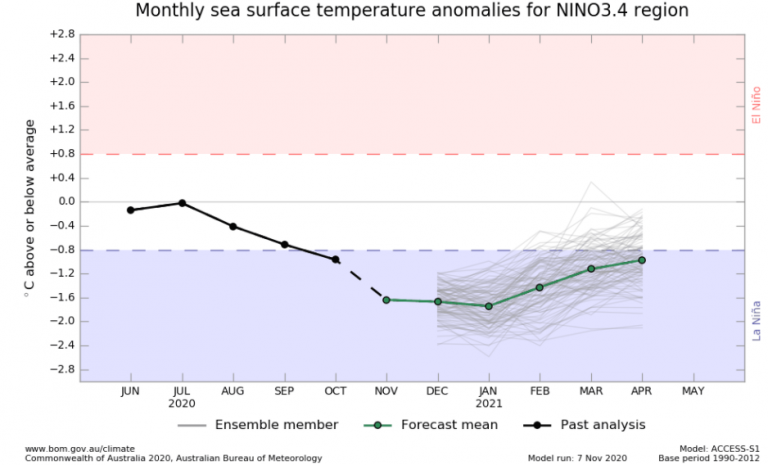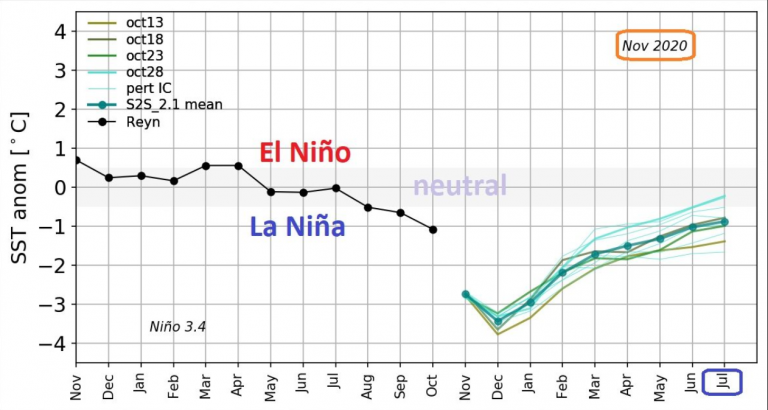Data from NASA point to a powerful Pacific La Nina event in the works, and so with it could bring a considerable drop in the mean global surface temperature in 2021.
According to the latest report issued by the Australian Bureau of Meteorology (BOM), the La Niña conditions continue in the tropical Pacific: “International climate models suggest it is likely to continue at least through February 2021.”
Peak La Niña conditions expected in January, 2021. Chart source: BOM.
Central and eastern tropical Pacific Ocean sea surface temperatures (SSTs) are at La Niña levels, and remain similar compared to two weeks ago, reports the BOM. “Models continue to suggest some possibility that central and eastern tropical Pacific SSTs could briefly reach levels similar to 2010–12, with the peak most likely in December 2020 or January 2021.”
The BOM uses the ACCESS–S model for generating its forecasts.
NASA: temperature deviation to -3°C
Mean while Snowfan here reports that NASA prognoses are in fact expecting an “unusually powerful La Niña development, with cooler than normal surface anomalies extending into the summer of 2021 and which could become an extended year-long event, which also occurred in 2010 – 2012.
Source: BOM NASA/GMAO-ENSO-Prognosen
“November 2020 sees an unusually strong La Niña in the equatorial Pacific with temperature deviations down to below -3°C and with unusually long duration until NH summer 2021,” Snowfan writes. “If the current NASA forecast is correct, a multi-year La Niña could develop into 2022, just like in 2010-2012.”
Strong and long La Niña events cool the Earth by several tenths of a degree Celsius with a time lag. The overall global cooling occurring since 2016 will therefore continue at least until 2021 and could even last until 2022.
Fuel for future bush fires
The BOM notes that La Niña events “typically enhance spring rainfall in northern, central and eastern Australia” and that during a La Niña summer, “above average rainfall is also typical for much of eastern Australia, but particularly eastern Queensland”. But such good news comes with a price: Rainfall means more vegetation growth, which in turn will lead to much more fuel ffor uture bush fires when drought conditions return, as they always inevitably do.







NASA forecasts are worth about as much as MSM reporting or political polling. Worse than guessing.
Shoki,
I thought those charlatans said “models” predict La Nina. Now where have we heard of models before I wonder?
“Rainfall means more vegetation growth, which in turn will lead to much more fuel ffor uture bush fires when drought conditions return, as they always inevitably do.” Unless we apply the usual bush/forest management practises….
Six weeks ago the forecast was for a warm and dry fall in the USA Pacific Northwest (aka WA & OR).
This week the Washington Cascades is getting a big dump of snow.
The last La Niña formed in the winter of 2017-18. Washington’s average snow pack then was 113% of normal.
Skiers are hopeful. Avalanche control and truckers are less enthusiastic.
thank you
[…] adequate protection Breakthrough finding offers clues about why certain COVID-19 patients die Considerable drop in the mean global surface temperature in 2021 Coronavirus lockdown in France to remain in effect until Dec .. Covid-19 has unleashed state […]
[…] Read more at No Tricks Zone […]
thank you :
[…] Cooling Planet: NASA Projects Deep La Niña Event, Peak Temperature Deviation Up To -3°C! […]